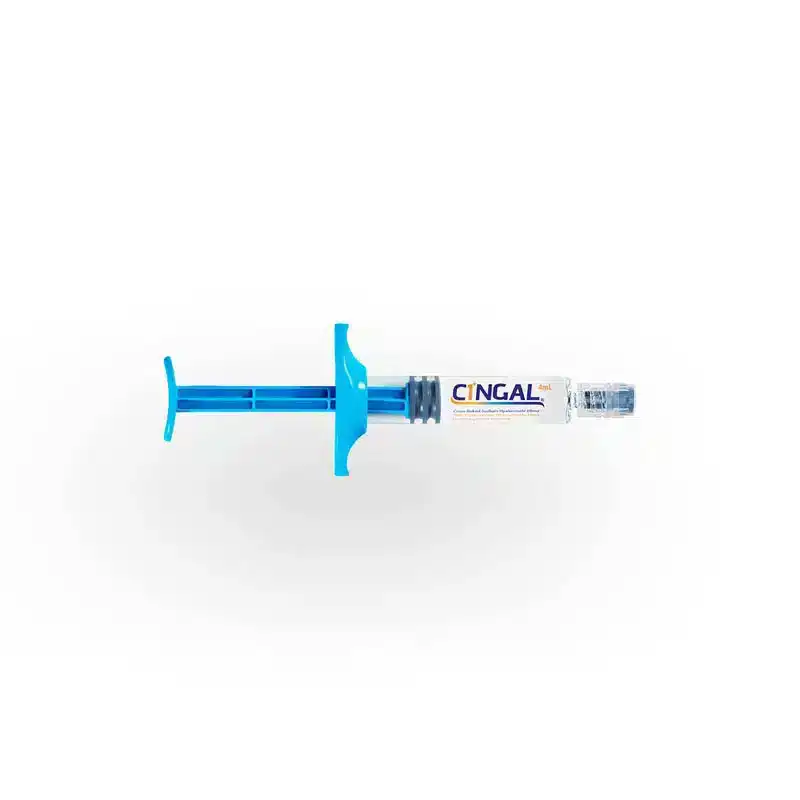Business Hours: Monday - Friday: 9 AM - 6 PM EST

Cingal vs Synvisc – Comparing OA Treatments
David Fuller
Last Updated On: November 25, 2024
Viscosupplementation is a widely used treatment for knee osteoarthritis (OA), offering pain relief and improved joint function through hyaluronic acid injections. Research shows that approximately 60% of patients experience significant pain relief lasting up to six months, making it an effective option for managing OA symptoms.
Of the many available options, Cingal and Synvisc are popular, each offering distinct benefits. Cingal combines hyaluronic acid with a corticosteroid for immediate and sustained relief, while Synvisc uses a unique hyaluronic acid formulation designed to cushion and lubricate the joint. Understanding the differences between these treatments can help patients and practitioners make informed decisions.
In this article, we will explore the key features, effectiveness, safety profiles, and patient suitability of Cingal vs Synvisc, providing a comprehensive comparison to guide your choice.
Key Takeaways
- Cingal combines hyaluronic acid and corticosteroids for rapid pain relief and sustained joint lubrication. It is ideal for those seeking immediate relief from osteoarthritis pain.
- Synvisc only uses hyaluronic acid for gradual but long-lasting relief. Its cushioning effect mimics natural joint fluid, improving movement and reducing discomfort.
- Both treatments are effective, but Cingal provides quicker results, while Synvisc delivers relief over an extended period.
- Cingal requires one injection, while Synvisc involves a series of three injections over weeks, allowing flexibility based on patient preferences.
About: Operating since 2016, Med Supply Solutions is known for being one of the industry’s top and trusted suppliers of cosmetic and viscosupplementation products. Contact our sales department for more information about buying Cingal online.

CINGAL®
Hyaluronic acid
TRIAMCINOLONE HEXACETONIDE
$249.00
Tier pricing
Save 4.02%
3 or more
$239.00 each
Save 6.02%
11 or more
$234.00 each
Save 8.03%
21 or more
$229.00 each
Introduction to Cingal and Synvisc

Osteoarthritis (OA) is a common condition characterized by the gradual breakdown of joint cartilage, leading to pain, stiffness, and reduced mobility. The knees are often affected, making everyday activities difficult for many individuals and increasing the demand for effective pain relief solutions.
Viscosupplementation injections have emerged as a promising treatment for knee OA. They offer targeted relief by replenishing the joint’s natural lubrication. Cingal and Synvisc stand out among the available options for their proven efficacy.
Cingal combines hyaluronic acid with a corticosteroid, delivering rapid pain relief and improved joint function. On the other hand, Synvisc uses a specialized hyaluronic acid formulation to restore cushioning and lubrication in the joint. Each treatment is tailored to address specific patient needs and symptoms, providing unique benefits for managing OA.
Composition and Mechanism of Action

Cingal is a unique viscosupplement that combines hyaluronic acid with a corticosteroid, offering rapid and sustained relief for knee pain caused by osteoarthritis (OA). The steroid component provides immediate anti-inflammatory effects, quickly reducing pain and swelling. Meanwhile, the hyaluronic acid improves joint lubrication and cushioning, enhancing mobility over time. This dual-action mechanism makes Cingal a versatile option for addressing short- and long-term OA symptoms.
In contrast, Synvisc relies solely on hyaluronic acid, a substance naturally found in joint fluid. Synvisc alleviates knee pain and stiffness caused by OA by restoring lubrication and cushioning. Its formulation mimics the viscoelastic properties of healthy synovial fluid, promoting smoother joint movement.
Efficacy and Duration of Action

Cingal delivers fast and long-lasting pain relief through its dual-action formulation, combining hyaluronic acid with a corticosteroid. The steroid component provides immediate anti-inflammatory effects, reducing pain and swelling within days, while hyaluronic acid enhances joint lubrication for sustained relief. Clinical studies indicate that Cingal can outperform other treatments like Monovisc in relieving pain within three weeks, with effects lasting up to six months.
Synvisc, relying solely on hyaluronic acid, offers effective long-term relief by mimicking the natural cushioning and lubricating properties of healthy synovial fluid. While it may take longer to alleviate pain than Cingal, patients often experience relief within one to two weeks of treatment. The benefits of Synvisc typically last for several months, making it a reliable option for managing osteoarthritis symptoms.
Indications and Injection Techniques
Cingal and Synvisc are both used to treat pain associated with osteoarthritis (OA) of the knee in patients who have not responded adequately to conservative non-pharmacologic therapy and simple analgesics, such as acetaminophen.
Injection Techniques
- Cingal: Administered as a single intra-articular injection into the knee joint space. The injection uses a sterile, disposable hypodermic needle (18-21 gauge), ensuring proper penetration into the synovial cavity. Aseptic technique is crucial to prevent infection.
- Synvisc: Typically administered in a series of three weekly injections, each containing 2 mL of the solution. The injection is given intra-articularly using an 18- to 20-gauge needle. Before injection, any synovial fluid or effusion should be aspirated. Aseptic technique and proper needle placement are essential.
Considerations for Patient Suitability and Treatment Administration
- Cingal: Not recommended for patients with known hypersensitivity to its components, active infections, or systemic bleeding disorders. Patients with impaired cardio-renal function or endocrine disorders should first consult a trusted expert before going through with the treatment.
- Synvisc: Contraindicated in patients with known hypersensitivity to hyaluronan, active infections, or severe inflammation in the knee. It should not be injected intravascularly or extra-articularly. Patients should avoid strenuous activities for 48 hours post-injection
Potential Side Effects and Safety Profile
Both Cingal and Synvisc are safe and effective for treating knee osteoarthritis, though patients may experience mild reactions after treatment.
Common Cingal injection side effects include temporary swelling, pain, or redness at the injection site. These effects typically subside within a few days and are rarely severe. Patients might sometimes experience joint stiffness or a sensation of warmth in the knee, but these symptoms are manageable with proper aftercare.
Synvisc also shares similar side effects, such as mild swelling, bruising, or discomfort at the injection site. Serious complications, like infections or significant joint inflammation, are very rare and usually associated with improper administration.
Conclusion
Choosing between Cingal and Synvisc ultimately depends on a patient’s specific needs and treatment goals. Cingal’s combination of hyaluronic acid and a steroid offers rapid pain relief and sustained joint lubrication, making it ideal for those seeking immediate results. In contrast, Synvisc relies solely on hyaluronic acid, providing gradual but long-lasting relief through enhanced joint cushioning and lubrication.
Both treatments effectively address knee osteoarthritis pain but work differently. Consulting a healthcare provider to evaluate individual symptoms, lifestyle, and preferences ensures a personalized approach to managing knee OA and achieving the best possible outcomes.
FAQs
1. What is the primary difference between Cingal and Synvisc?
Cingal combines hyaluronic acid with a corticosteroid for immediate pain relief and joint lubrication, while Synvisc uses only hyaluronic acid to mimic natural joint fluid, offering gradual but sustained relief.
2. How long do the effects of Cingal and Synvisc last?
Cingal typically provides relief for up to six months, while Synvisc can also last several months, depending on the individual.
3. Who is a suitable candidate for these treatments?
Both treatments are suitable for osteoarthritis patients who have not found relief with conservative treatments like physical therapy or oral medications. A healthcare provider will evaluate individual needs to determine the best option.
References
Peck, J., Slovek, A., Miro, P., Vij, N., Traube, B., Lee, C., Berger, A. A., Kassem, H., Kaye, A. D., Sherman, W. F., & Abd-Elsayed, A. (2021). A Comprehensive Review of Viscosupplementation in Osteoarthritis of the Knee. Orthopedic reviews, 13(2), 25549. https://doi.org/10.52965/001c.25549
Anika Therapeutics. (n.d.). Cingal. Retrieved November 18, 2024, from https://anika.com/medical/products/cingal/
Products
Cart
Log In
Newsletter
Subscribe for exclusive offers and updates on new arrivals
Share feedback at:
Working Hours
Monday to Friday: 9 AM to 6 PM EST
The Most Popular Brands
Med Supply Solutions
Support
Copyright 2025. Med Supply Solutions